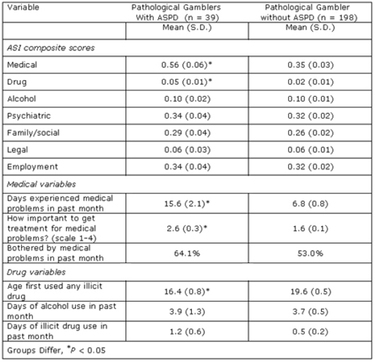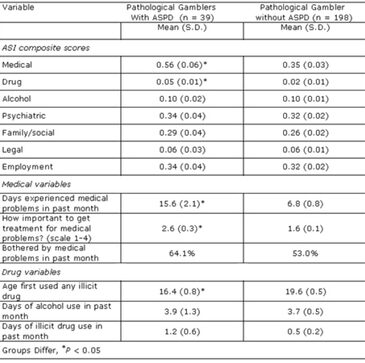Researchers have examined the relationship between co-occurring psychopathology and gambling. However, relatively few studies focus on personality disorders and pathological gambling. Blaszczynski & Steel (1998) found that an overwhelming majority (93%) of pathological gamblers exhibited personality disorder(s). Additionally, pathological gamblers with antisocial personality disorder (29%) had more severe gambling-related problems. The prevalence of antisocial personality disorder among pathological gamblers is as high as forty percent in some studies (e.g., Bland, Newman, Orn, & Stebelsky, 1993). This week’s WAGER reports on a recent study that closely examined antisocial personality disorder among treatment-seeking pathological gamblers and its impact on their mental and physical health (Pietrzak & Petry, 2005).
Researchers recruited study participants through advertisements for gambling treatment research. In order to be eligible, participants had to be at least 18 years old and diagnosed with pathological gambling. Participants who could not speak English and/or had severe psychiatric problems were excluded. Two hundred and thirty-seven pathological gamblers participated. The investigators administered the South Oaks Gambling Screen (SOGS), the antisocial personality module from the Structured Clinical Interview for DSM-IV Personality Disorders, the Addiction Severity Index (ASI), and the Brief Symptom Inventory (BSI) to the participants at intake. The Addiction Severity Index assessed substance abuse problems and the Brief Symptom Inventory measured psychological distress. To qualify for antisocial personality disorder, participants had to endorse six or more criteria: three or more for conduct disorder in adolescence and three or more for antisocial symptoms in adulthood. To compare psychological symptoms of pathological gamblers with and without antisocial personality disorder, the investigators used general linear models controlling for other demographic variables (i.e., age, gender, substance abuse, and education). The models used ASI and BSI scores as dependent variables.
Table 1 Adjusted Means for Composite ASI Scores and ASI Medical and Drug Variables. Adapted from (Pietrzak & Petry, 2005)

The results showed that 16.5% of pathological gamblers were diagnosed with antisocial personality disorder (ASPD). As seen in Table 1, pathological gamblers with antisocial personality disorder reported more severe drug problems as well as medical problems. Antisocial pathological gamblers started using drugs at a younger age and were more likely to have used nicotine (89.7% versus 74.7%), marijuana (59.0% versus 26.8%), cocaine (53.8% versus 17.7%), heroin (28.2% versus 8.1%), amphetamines (25.6% versys 3.5%), hallucinogens (23.1% versus 2.5%), and sedatives (12.8% versus 2.0%) than pathological gamblers without ASPD. Pathological gamblers with ASPD scored higher than gamblers without the disorder on three BSI subscales: paranoid ideation, somatization, and phobic anxiety. Additional analyses revealed that, compared to pathological gamblers without ASPD, gamblers with ASPD were younger, started gambling at a younger age, and endorsed more DSM criteria for pathological gambling. Pathological gamblers with ASPD also scored higher on the SOGS gambling screen and gambled more days in the past month. In stark contrast to gamblers without ASPD, antisocial gamblers were more likely to steal money to gamble in the past year.
One limitation of the study is that the results may not be generalizable to all pathological gamblers, because the participants were seeking treatment for gambling related problems; most people with gambling problems do not seek treatment. The self reporting also is another limitation, because participants with ASPD might have been more likely to misreport, since “deceitfulness” is characteristic of the disorder.
This study not only highlights the significant prevalence of ASPD among pathological gamblers, but also suggests that pathological gamblers with ASPD are different from pathological gamblers without ASPD in terms of coping and health. These important differences among treatment-seeking pathological gamblers need to be considered and warrant comprehensive assessment efforts. It is likely that differences between pathological gamblers with and without ASPD affect treatment compliance, involvement and outcome and that these two subtypes might require different types of treatment. Further research is needed to determine the nature of the relationship between pathological gambling and ASPD. At one point, ASPD was an exclusion criterion for the DSM diagnosis of pathological gambling because the DSM assumed that if the two overlapped, pathological gambling was necessarily an expression of ASPD. However, empirical study is necessary to test this assumption and determine whether pathological gambling is an expression of ASPD, whether the two are distinct, or whether they both might be part of a larger disorder.
What do you think? Comments on this article can be addressed to Sarbani Hazra.
References
Bland, R. C., Newman, S. C., Orn, H., & Stebelsky, G. (1993). Epidemiology of pathological gambling in Edmonton. Canadian Journal of Psychiatry, 38(2), 108-112.
Blaszczynski, A., & Steel, Z. (1998). Personality disorders among pathological gamblers. Journal of Gambling Studies, 14 (1), 51-71.
Pietrzak, R. H., & Petry, N. M. (2005). Antisocial personality disorder is associated with increased severity of gambling, medical, drug and psychiatric problems among treatment-seeking pathological gamblers. Addiction, 100(8), 1183-1193.




